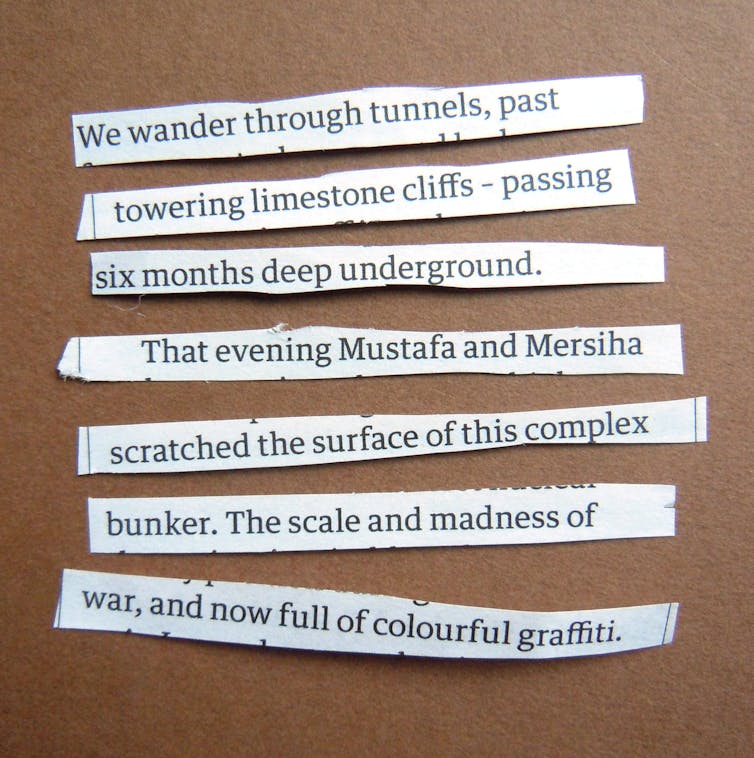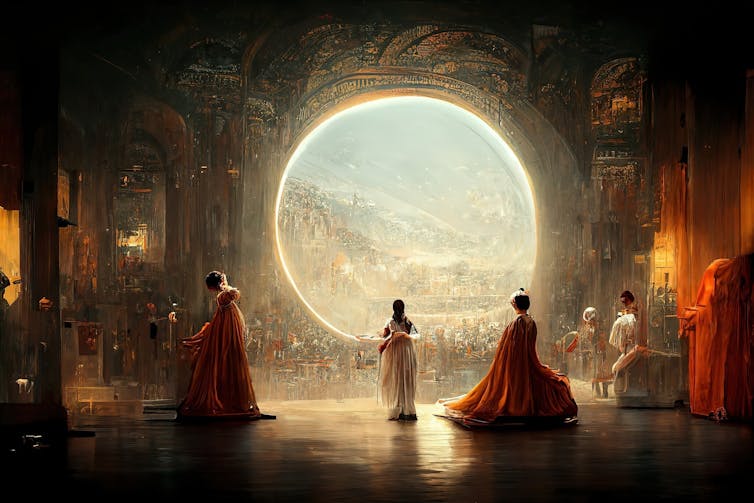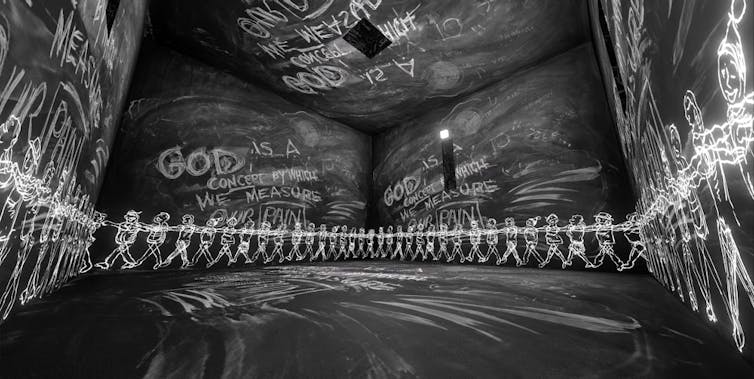Art
From Duchamp to AI: the transformation of authorship in art
The 19th century concept of authorship revolved around the romantic view of the artist as a lone genius. In this model, every stroke of the brush, every note played and every word written was the product of a singular creative mind, bearing the unique imprint of its creator.
However, the landscape of artistic creation began to shift dramatically with the advent of the 20th century, with artists like Marcel Duchamp, John Cage and William S. Burroughs pioneering new creative approaches such as aleatoricism, the cut-up technique and “randomness” which began recast the role of the author.
Now, AI technology looks likely to cause as much disruption as the previous revolutions combined.
Just as the artists of the last revolution grappled with their age’s social and spiritual upheavals, our artists today must rise to the challenge and engage the shock of the new that now confronts us all. AI will force artists (along with the rest of us) to examine what it means to be a “creator” and, ultimately, perhaps what it means to be human.
Disrupting the artistic landscape
Conceptual art pioneer Marcel Duchamp radically altered the artistic landscape with his work, Fountain (1917) – a urinal signed “R. Mutt”.
He argued that art wasn’t confined to traditional craftsmanship but could spring from the act of selection and presentation.

Wikipedia, CC BY
Composer John Cage took this artistic revolution a step further. His composition 4’33 (1952), where the performer remains silent for four minutes and 33 seconds, is a powerful example of a work that questions the definition of music itself. Cage’s piece isn’t just any random stretch of silence – it is art because Cage himself, a human, framed it, turning the act of listening into a creative process.
Following suit, William S. Burroughs disrupted traditional narratives with his cut-up technique, emphasising the non-linear progression of storytelling and demonstrating that authorship could extend to the reassembling of pre-existing material.

Wikipedia, CC BY
David Bowie famously used this technique for writing lyrics in some of his songs, especially in his work from the 1970s. Songs from albums like Diamond Dogs and Young Americans used cutups to create distinctive, unexpected, and often cryptic lyrics. Bowie would cut up his writings or other texts, rearrange them, and use the resulting fragments as the starting point for his songwriting. This allowed him to break free from linear thought and traditional songwriting cliches and to explore more abstract and unpredictable forms of expression.
These early disruptions laid the groundwork for today’s art and machine learning intersection. They questioned the traditional concept of authorship. Now, technology is challenging it again.
Moreover, this time around, even the role of the audience is likely to change.
Modern art
Jason M. Allen, a digital artist from Pueblo West, became one of the first creators to win a prize for AI generated art. His role was to input a text prompt into the AI tool, which then transformed it into a hyper-realistic graphic based on its training from millions of previously processed images.
In this process, Allen’s creativity came into play in formulating the correct prompts to instruct the AI, effectively guiding or curating the AI’s output.
In this case, the artist becomes a sort of co-pilot, steering the AI’s capabilities to produce a desired output. This new process raises questions about authorship and authenticity in art. It underscores how technology redefines the traditional artistic process, with artists becoming more like orchestrators of complex AI systems.

Jason Allen/Discord, CC BY
Modern artists like Laurie Anderson have begun to harness machine learning to create novel works. Anderson’s work, Scroll (2021), is a fusion of religious text and her distinctive linguistic style generated through AI.
In both of these examples, the artist functions like a curator. The manual toil of writing, drawing or composing is replaced by an iterative process of discovery, filtering and refinement of instructions to the system.
These artists are pioneering a shift in the artist’s role. Instead of being the sole creators, artists now guide, shape and direct the creative output of machine learning systems. This transition certainly presents challenges, but it also uncovers a world of new artistic competencies and opportunities.

Laurie Anderson, CC BY
The future
Looking to the future, we can expect the interplay of art and technology to deepen. Artists who embrace this ever-evolving landscape will contribute their unique perspectives to the development of machine learning and shape our collective relationship with it.
This time around, the revolution will also extend to the audience’s role. Passive viewers become participants in the making and remaking of the art. The very same AI systems that empower artists can empower the audience.
Audience members can utilise AI tools to generate art, even if they do not have traditional artistic skills. AI democratises the art-making process, making it accessible to anyone with access to the technology.
This could significantly expand the art world, as more people can become creators, contributing their own perspectives and ideas. One example is a project called Tamper (2019), developed by John Underkoffler for the AMPAS, Getty and other museums. This project lets museum visitors build collages out of material taken from a museum’s collection.
We must prepare the coming generations for this rapidly changing creative landscape, fostering their ability to co-pilot with AI systems. As we move further into the age of machine learning, artists must reclaim their position at the forefront of creative thought and innovation.

Art
Calvin Lucyshyn: Vancouver Island Art Dealer Faces Fraud Charges After Police Seize Millions in Artwork

In a case that has sent shockwaves through the Vancouver Island art community, a local art dealer has been charged with one count of fraud over $5,000. Calvin Lucyshyn, the former operator of the now-closed Winchester Galleries in Oak Bay, faces the charge after police seized hundreds of artworks, valued in the tens of millions of dollars, from various storage sites in the Greater Victoria area.
Alleged Fraud Scheme
Police allege that Lucyshyn had been taking valuable art from members of the public under the guise of appraising or consigning the pieces for sale, only to cut off all communication with the owners. This investigation began in April 2022, when police received a complaint from an individual who had provided four paintings to Lucyshyn, including three works by renowned British Columbia artist Emily Carr, and had not received any updates on their sale.
Further investigation by the Saanich Police Department revealed that this was not an isolated incident. Detectives found other alleged victims who had similar experiences with Winchester Galleries, leading police to execute search warrants at three separate storage locations across Greater Victoria.
Massive Seizure of Artworks
In what has become one of the largest art fraud investigations in recent Canadian history, authorities seized approximately 1,100 pieces of art, including more than 600 pieces from a storage site in Saanich, over 300 in Langford, and more than 100 in Oak Bay. Some of the more valuable pieces, according to police, were estimated to be worth $85,000 each.
Lucyshyn was arrested on April 21, 2022, but was later released from custody. In May 2024, a fraud charge was formally laid against him.
Artwork Returned, but Some Remain Unclaimed
In a statement released on Monday, the Saanich Police Department confirmed that 1,050 of the seized artworks have been returned to their rightful owners. However, several pieces remain unclaimed, and police continue their efforts to track down the owners of these works.
Court Proceedings Ongoing
The criminal charge against Lucyshyn has not yet been tested in court, and he has publicly stated his intention to defend himself against any pending allegations. His next court appearance is scheduled for September 10, 2024.
Impact on the Local Art Community
The news of Lucyshyn’s alleged fraud has deeply affected Vancouver Island’s art community, particularly collectors, galleries, and artists who may have been impacted by the gallery’s operations. With high-value pieces from artists like Emily Carr involved, the case underscores the vulnerabilities that can exist in art transactions.
For many art collectors, the investigation has raised concerns about the potential for fraud in the art world, particularly when it comes to dealing with private galleries and dealers. The seizure of such a vast collection of artworks has also led to questions about the management and oversight of valuable art pieces, as well as the importance of transparency and trust in the industry.
As the case continues to unfold in court, it will likely serve as a cautionary tale for collectors and galleries alike, highlighting the need for due diligence in the sale and appraisal of high-value artworks.
While much of the seized artwork has been returned, the full scale of the alleged fraud is still being unraveled. Lucyshyn’s upcoming court appearances will be closely watched, not only by the legal community but also by the wider art world, as it navigates the fallout from one of Canada’s most significant art fraud cases in recent memory.
Art collectors and individuals who believe they may have been affected by this case are encouraged to contact the Saanich Police Department to inquire about any unclaimed pieces. Additionally, the case serves as a reminder for anyone involved in high-value art transactions to work with reputable dealers and to keep thorough documentation of all transactions.
As with any investment, whether in art or other ventures, it is crucial to be cautious and informed. Art fraud can devastate personal collections and finances, but by taking steps to verify authenticity, provenance, and the reputation of dealers, collectors can help safeguard their valuable pieces.
Art
Ukrainian sells art in Essex while stuck in a warzone – BBC.com
[unable to retrieve full-text content]
Ukrainian sells art in Essex while stuck in a warzone BBC.com

Source link
Art
Somerset House Fire: Courtauld Gallery Reopens, Rest of Landmark Closed
The Courtauld Gallery at Somerset House has reopened its doors to the public after a fire swept through the historic building in central London. While the gallery has resumed operations, the rest of the iconic site remains closed “until further notice.”
On Saturday, approximately 125 firefighters were called to the scene to battle the blaze, which sent smoke billowing across the city. Fortunately, the fire occurred in a part of the building not housing valuable artworks, and no injuries were reported. Authorities are still investigating the cause of the fire.
Despite the disruption, art lovers queued outside the gallery before it reopened at 10:00 BST on Sunday. One visitor expressed his relief, saying, “I was sad to see the fire, but I’m relieved the art is safe.”
The Clark family, visiting London from Washington state, USA, had a unique perspective on the incident. While sightseeing on the London Eye, they watched as firefighters tackled the flames. Paul Clark, accompanied by his wife Jiorgia and their four children, shared their concern for the safety of the artwork inside Somerset House. “It was sad to see,” Mr. Clark told the BBC. As a fan of Vincent Van Gogh, he was particularly relieved to learn that the painter’s famous Self-Portrait with Bandaged Ear had not been affected by the fire.
Blaze in the West Wing
The fire broke out around midday on Saturday in the west wing of Somerset House, a section of the building primarily used for offices and storage. Jonathan Reekie, director of Somerset House Trust, assured the public that “no valuable artefacts or artworks” were located in that part of the building. By Sunday, fire engines were still stationed outside as investigations into the fire’s origin continued.
About Somerset House
Located on the Strand in central London, Somerset House is a prominent arts venue with a rich history dating back to the Georgian era. Built on the site of a former Tudor palace, the complex is known for its iconic courtyard and is home to the Courtauld Gallery. The gallery houses a prestigious collection from the Samuel Courtauld Trust, showcasing masterpieces from the Middle Ages to the 20th century. Among the notable works are pieces by impressionist legends such as Edouard Manet, Claude Monet, Paul Cézanne, and Vincent Van Gogh.
Somerset House regularly hosts cultural exhibitions and public events, including its popular winter ice skating sessions in the courtyard. However, for now, the venue remains partially closed as authorities ensure the safety of the site following the fire.
Art lovers and the Somerset House community can take solace in knowing that the invaluable collection remains unharmed, and the Courtauld Gallery continues to welcome visitors, offering a reprieve amid the disruption.
-

 Sports21 hours ago
Sports21 hours agoKirk’s walk-off single in 11th inning lifts Blue Jays past Cardinals 4-3
-

 Sports21 hours ago
Sports21 hours agoCanada’s Marina Stakusic falls in Guadalajara Open quarterfinals
-

 Sports21 hours ago
Sports21 hours agoStampeders return to Maier at QB eyeing chance to get on track against Alouettes
-

 News21 hours ago
News21 hours agoMetro Vancouver’s HandyDART strike continues after talks break with no deal
-

 News21 hours ago
News21 hours ago26-year-old son is accused of his father’s murder on B.C.’s Sunshine Coast
-

 News4 hours ago
News4 hours agok.d. lang gets the band back together for Canadian country music awards show
-

 News21 hours ago
News21 hours agoLongtime PC MPP Lisa MacLeod announces she will not seek re-election
-

 News20 hours ago
News20 hours agoRCMP arrest second suspect in deadly shooting east of Calgary





















